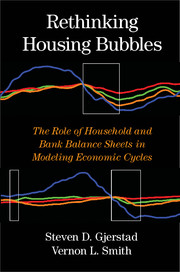 Rethinking Housing Bubbles
Rethinking Housing Bubbles Book contents
- Frontmatter
- Contents
- Acknowledgments
- 1 Economic Crises, Economic Policy, and Economic Analysis
- 2 Goods and Services Markets versus Asset Markets
- 3 Asset Performance
- 4 The Great Depression
- 5 The Postwar Recessions
- 6 What May Have Triggered or Sustained the Housing Bubble (1997–2006)?
- 7 The Bubble Bursts
- 8 Blindsided Experts
- 9 What Might Be Done?
- 10 Learning from Foreign Economic Crises
- 11 Summary: What Have We Learned?
- Index
- References
8 - Blindsided Experts
Published online by Cambridge University Press: 05 June 2014
- Frontmatter
- Contents
- Acknowledgments
- 1 Economic Crises, Economic Policy, and Economic Analysis
- 2 Goods and Services Markets versus Asset Markets
- 3 Asset Performance
- 4 The Great Depression
- 5 The Postwar Recessions
- 6 What May Have Triggered or Sustained the Housing Bubble (1997–2006)?
- 7 The Bubble Bursts
- 8 Blindsided Experts
- 9 What Might Be Done?
- 10 Learning from Foreign Economic Crises
- 11 Summary: What Have We Learned?
- Index
- References
Summary
The rise in subprime mortgage lending likely boosted home sales somewhat, and curbs on this lending are expected to be a source of some restraint on home purchases and residential investment in coming quarters. Moreover, we are likely to see further increases in delinquencies and foreclosures this year and next as many adjustable-rate loans face interest-rate resets. All that said, given the fundamental factors in place that should support the demand for housing, we believe the effect of the troubles in the subprime sector on the broader housing market will likely be limited, and we do not expect significant spillovers from the subprime market to the rest of the economy or to the financial system. The vast majority of mortgages, including even subprime mortgages, continue to perform well. Past gains in house prices have left most homeowners with significant amounts of home equity, and growth in jobs and incomes should help keep the financial obligations of most households manageable.
– Ben Bernanke, May 17, 2007Although I was concerned about the potential fallout from a collapse of the housing market, I think that it is fair to say that these costs have turned out to be much greater than I and many other observers imagined. In particular, I and other observers underestimated the potential for house prices to decline substantially, the degree to which such a decline would create difficulties for homeowners, and, most important, the vulnerability of the broader financial system to these events.
– Donald L. Kohn, Board of Governors of the Federal Reserve System, November 19, 2008I got back and I called some friends in the Federal Reserve. “How big is this subprime mortgage thing?” I must admit, the answer I got from them first was, “I don’t know.” Then, they called me back later, and they told me, “Well, it looks like it’s over a trillion dollars.” I had no imagination that this subprime mortgage thing was over a trillion dollars.
– Paul Volcker interview (Feldstein, 2013, p. 114)- Type
- Chapter
- Information
- Rethinking Housing BubblesThe Role of Household and Bank Balance Sheets in Modeling Economic Cycles, pp. 203 - 222Publisher: Cambridge University PressPrint publication year: 2014


